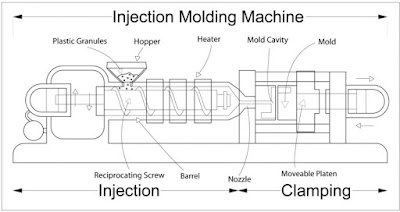How does injection moulding work?
Injection moulding along with extrusion ranks as one of the prime processes for producing plastic articles. It is a fast process and is used to produce large numbers of identical items from high precision engineering components to disposable consumer goods.
Most thermoplastics can be processed by injection moulding; the most common materials used include:
- Acrylonitrile-Butadiene-Styrene ABS
- Nylon PA
- Polycarbonate PC
- Polypropylene PP
Injection mouldings count for a significant proportion of all plastics products from micro parts to large components such as car bumpers and wheelie bins. Virtually all sectors of manufacturing use injection moulded parts. The flexibility in size and shape possible through use of this process has consistently extended the boundaries of design in plastics and enabled significant replacement of traditional materials thanks to light weight and design freedom.
Material granules for the part is fed via a hopper into a heated barrel, melted using heater bands and the frictional action of a reciprocating screw barrel. The plastic is then injection through a nozzle into a mould cavity where it cools and hardens to the configuration of the cavity. The mould tool is mounted on a moveable platen – when the part has solidified, the platen opens and the part is ejected out using ejector pins.
After a product is designed, usually by an industrial designer or an engineer, moulds are made by a mouldmaker (or toolmaker) from metal, usually either steel or aluminum, and precision-machined to form the features of the desired part..
Parts to be injection moulded must be very carefully designed to facilitate the moulding process; the material used for the part, the desired shape and features of the part, the material of the mould, and the properties of the moulding machine must all be taken into account. The versatility of injection moulding is facilitated by this breadth of design considerations and possibilities.
